Biggest Sports Stadiums in the World 2024
Stadiums are a place of pride for most sports fanatics. It’s the home field, it’s where they spend hours cheering on their favorite team as they play. They are also places to celebrate victories and mourn defeats (hopefully not too many). Depending on what sport you follow, there is a stadium that will be perfect for your needs!
It’s no secret that sports stadiums are some of the most iconic buildings in the world. The size, design, and history of these venues is often awe-inspiring to spectators and athletes alike. This blog post will explore 10 of the biggest stadiums in the world by capacity.
Stadiums are a way to show the world that you’re best, your team is best and that you can host the biggest sporting events. They also have a lot of history in them from hosting past Olympics, World Cups or even concerts.
The largest stadiums in the world are huge and take up a lot of space. They can hold hundreds of thousands of people, and sometimes more. These include some famous venues that you would expect to be on this list, like Wembley Stadium or the Maracanã stadium in Brazil, but there are also some surprising entrants as well.
Top 10 Biggest stadiums in the World 2024
Here are the 10 biggest sports stadiums in the world by capacity:
- Bryant-Denny Stadium – 100,077 Capacity
- Darrell K Royal-Texas Memorial Stadium – 100,119 Capacity
- Tiger Stadium – 102,321 Capacity
- Neyland Stadium – 102,455 Capacity
- Kyle Field – 102,733 Capacity
- Ohio Stadium – 102,780 Capacity
- Beaver Stadium – 106,572 Capacity
- Michigan Stadium – 107,601 Capacity
- Sardar Patel Stadium – 110,000 Capacity
- Rungrado May Day Stadium – 150,000 Capacity
10. Bryant-Denny Stadium – 100,077 capacity
Bryant-Denny Stadium is the home of the Alabama Crimson Tide, and with an official capacity of 100,0777 spectators it isn’t just one of the largest stadiums in America. It’s also one of the most famous football venues in the country as well. Bryant Denny stadium has seen some incredible games, including a victory over Notre Dame which has been dubbed the ‘Game of the Century’.
Bryant-Denny Stadium is usually seen as an intimidating place to play. The structure itself was built in 1929, and at a cost of $250,000 it had seating for 27,075 spectators before being expanded in 1948 with an extra capacity for another 220,777 seats. It was expanded again in 1998, before being upgraded with an extra capacity of up to 83,000 spectators for the University’s new South endzone expansion project.
Bryant Denny stadium has seen some incredible games, including a victory over Notre Dame which has been dubbed the ‘Game of the Century’. It is one of the biggest stadiums in the world 2024.
9. Darrell K Royal-Texas Memorial Stadium – 100,119 capacity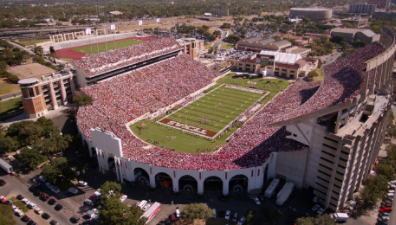
One of the oldest stadiums in NCAA Division I football is Darrell K Royal-Texas Memorial Stadium, which was built just over a hundred years ago. During its time it has seen some incredible games, and gone through a few renovations to keep up with modern day changes. The stadium can hold 100119 people at any one time – but this number can increase to over 100000 with the use of temporary seating.
The Darrell K Royal-Texas Memorial Stadium has been a part of American college sports for over one hundred years – it’s seen some incredible games and gone through a few renovations to keep up with modern day changes.
It has been home for both Longhorn Football and Women’s Soccer for over 100 years. It is one of the biggest stadiums in the world 2024.
8. Tiger Stadium – 102,321 capacity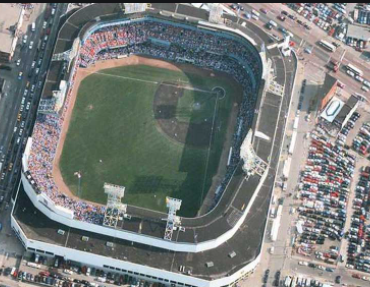
The LSU Tigers have played their home games at the LSU Tiger Stadium since it was built in 1924, and for many years this stadium has been a part of American college sports.
It is used mostly by the Louisiana State University Tigers football team but also does other events like concerts or other sporting events. The stadium can hold 102,321 people and was first built in 1924.
The LSU Tiger Stadium is the largest stadium in North America when it comes to capacity, holding 102,321 people at a time – an impressive feat for one of the oldest stadiums still standing today. The Louisiana State University Tigers football team has played their home games here since its construction back in 1924 and even though there have been significant renovations, the stadium still holds the same capacity that it had when it first opened.
The LSU Tiger Stadium was also one of three stadiums to be used in the 1994 FIFA World Cup and has hosted numerous other sporting events over its long history. This football powerhouse is a must-visit for any sports fan on their US tour.
The design of the stadium is modeled on an Oxford University model and its capacity was increased in 1991 when it became one of the first stadiums to have a movable field, which can be adjusted for football or soccer games.
In 1994, Tiger Stadium hosted three matches throughout World Cup ’94 – including Italy’s victorious win over Bulgaria.
The stadium also hosted two matches in the 1999 Women’s World Cup and has been a host of international soccer games as well.
It was declared an International Historic Civil Engineering Landmark by the American Society of Civil Engineers on 17th November, 2008.
7. Neyland Stadium – 102,455 capacity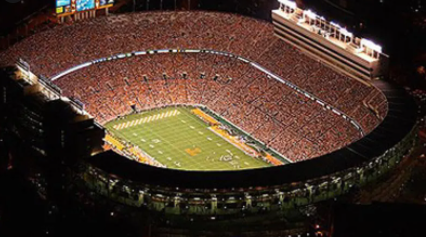
Neyland Stadium is home to the University of Tennessee Volunteers college football team. The stadium was built in 1921 and has a capacity of 102,455 people with an additional few thousand seats added for the 2008 season.
It includes a locker room that can hold up to 600 players on game day as well as over 400 toilets and urinals. Neyland Stadium is the second largest stadium in the state of Tennessee and one of the largest stadiums in America. It is one of the biggest stadiums in the world.
The inaugural game for Neyland was against Austin Peay on October 20th, 1921 with a final score of 23-0 over their opponents.
It has been home to some historic games such as the 1973 game against the number one ranked Alabama Crimson Tide, where Tennessee won 20-18.
Neyland Stadium has not only been the home for Volunteers football games but also hosted a few Tennessee Lady Vols basketball games and was even used in 1994 as host of soccer’s World Cup qualifier between Mexico and Canada.
The stadium is named after General Robert Neyland, who is the most winning coach in Tennessee football history.
The stadium has a capacity of 102,455 people with an elevation of 1707 feet above sea level. Neyland Stadium was ranked as the second largest college football stadium and fifth-largest sports arena by Forbes Magazine in 2012.
ALSO SEE: Top 10 Fastest Runners in the World
6. Kyle Field – 102,733 capacity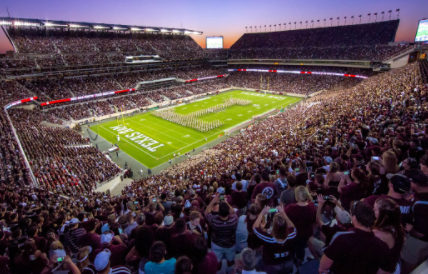
To make the stadium safe for spectators, Texas A&M installed permanent lighting in Kyle Field over thirty years ago. The school is now planning to add a sound system and more video boards as well as renovating other parts of the stadium such as restrooms. It is one of the biggest stadiums in the world.
Kyle Field has been ranked by one publication as “the toughest place to play in the SEC.”
The stadium is named after Peter J. Kyle, a former professor at A&M and soldier killed during World War I. Kyle Field has ranked as one of America’s largest college football stadiums since 1960s with a capacity that can be adjusted from 82,589 to 102,733 people (the current size).
5. Ohio Stadium – 102,780 capacity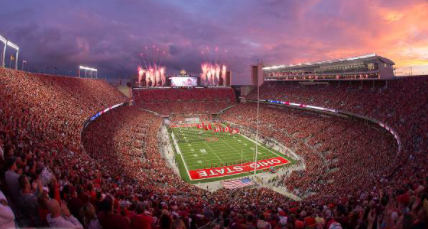
Ohio Stadium is a horseshoe-shaped stadium in Columbus, Ohio. It was built for the Ohio State Buckeyes football team and opened on November 25, 1922. The name “Ohio” comes from the school’s traditional nickname of “The Ohiors”—given to both its athletes as well as to those who support their teams.
The stadium is the largest in Ohio, and one of the largest football stadiums outside college property, with a seating capacity of 102,580.
Ohio Stadium was not originally designed to accommodate both professional and collegiate football games; but its closeness to Columbus’ downtown core has made it ideal for major events such as NHL exhibition games, NCAA Bowl games and other major sporting events. It is one of the biggest stadiums in the world.
4. Beaver Stadium – 106,572 capacity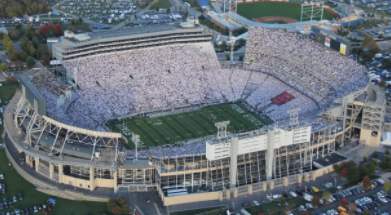
Beaver Stadium is the fourth-largest stadium in the world. The home of Penn State football and Nittany Lions, it was built for $13 million in 1960 by Dr. John David Crowther, who acquired title to a 13-acre lot from Pennsylvania Railroad after World War II. It opened on September 17th that same year.
Named after James Beaver, CEO of the Pennsylvania Railroad from 1859 to 1910. The stadium is the largest football and second-largest overall facility in America today.
It also has a greater seating capacity than any other Big Ten school’s campus stadium with an on-campus field; Michigan Stadium holds 109,901 attendees while Beaver Stadium holds 106,572. It is one of the biggest stadiums in the world 2024.
The largest single-game attendance was 115,109 on November 11th 2002 against Ohio State in a game which the Nittany Lions won 24-21 .
It has hosted five National Championship games: 1982, 1987 and 1994 Big Ten Football Championships; as well as 2000 and 2005 NCAA Division I Men’s Soccer Championships.
The stadium was constructed in 1939 and originally used for American football games, then later switched to primarily soccer purposes on October 20th 1970.
It is home to the Penn State Nittany Lions college team as well as several high school teams through the “Pennsylvania Interscholastic Athletic Association” with an attendance of 106,572.
3. Michigan Stadium – 107,601 capacity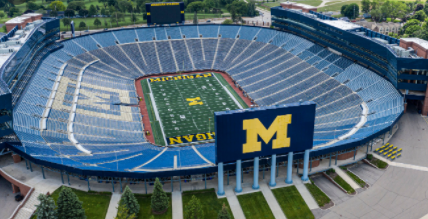
The Michigan stadium is the largest single-game attendance in college football history with over 116,000 people on September 22nd 2013.
This was also the first time that a Big Ten team played at night under floodlights. The game was against Notre Dame and ended up being an embarrassing score of 42 to 17 for Ohio State. The stadium is the home of the University of Michigan Wolverines.
It was formerly known as “Michigan Stadium” and It is one of the biggest stadiums in the world 2024.
The stadium opened in 1927 and features a collegiate plastic chair-back seating including three sections that are covered by either clear or tinted acrylic roofs . The largest crowd ever recorded to watch a football game at this stadium was 109,901 on October 20, 2010 for a college football game between the University of Michigan and Ohio State.
The stadium has been nicknamed “the Big House” and holds the world record for largest attendance at a sporting event. In 2012 it was named America’s Best Sports Stadium by Sporting News magazine in their annual survey of sports editors. It is the largest stadium in the United States.
The Big House is an informal nickname for a large football stadium. The term was coined by former University of Michigan head coach Bo Schembechler, and refers to the Wolverines’ home venue where they play their games.
2. Sardar Patel Stadium – 110,000 capacity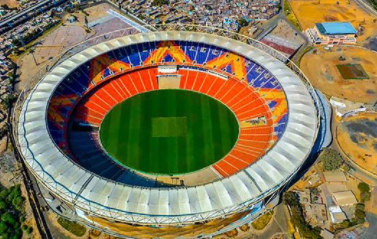
The second-biggest stadium in the world 2024 is Sardar Patel Stadium. This stadium was built for the 1987 Cricket World Cup and seats 110,000 people. It has been used for both cricket as well as football matches with a capacity of 114,254. The first game played at this venue took place on November 28th 1989 when India faced Sri Lanka.
Sardar Patel Stadium is one of the largest stadiums in India and is situated on National Sports Complex, located 22 km from Ahmedabad.
The stadium has a three tier gallery of 42000 capacity with provision for press boxes at two corners as well as TV galleries and VIP suites. It also provides protection against sun or rain during day-time matches owing to its air conditioned.
1. Rungrado May Day Stadium – 150,000 capacity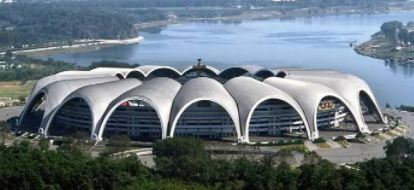
This stadium is also known as the ‘Grand People’s Study Hall’. It was built in 1989 and has been opened to public since 1991. Based on this, it can seat 150,000 people at a time. The Rungrado May Day Stadium is the biggest stadium in the world 2024 by 150,000 capacity with an outside area of 200 acres where numerous events are organized like sports matches, festivals and fairs.
The stadium is also located in the capital city of North Korea, Pyongyang and was opened on 15th April 1989 to celebrate International Women’s Day. The cost of construction for this stadium wasn’t revealed but it can seat 150,000 people at a time making it largest stadium worldwide by capacity with an outside area of 200 acres where numerous events are organized.
Here are the biggest football stadiums in the world 2024 by capacity:
- Camp Nou – 99,354 capacity
- Wembley Stadium – 90,000 capacity
- Signal Iduna Park – 81,365 capacity
- Stade de France – 81,338 capacity
- Santiago Bernabeu – 81,044 capacity
- San Siro Stadium – 80,018 capacity
- Maracana Stadium – 78,838 capacity
- Old Trafford – 76,000 capacity
- Allianz Arena – 75,024 capacity
- Stadio Olimpico – 72,698 capacity
Stadiums are the perfect place to host a sporting event, concert or festival. They can be used for other purposes as well, such as an amphitheater or public gathering space. We’ve put together this list of the 10 largest stadiums in the world by capacity and let you vote on your favorite one! Which stadium do you think is best? Comment below with your answer.
